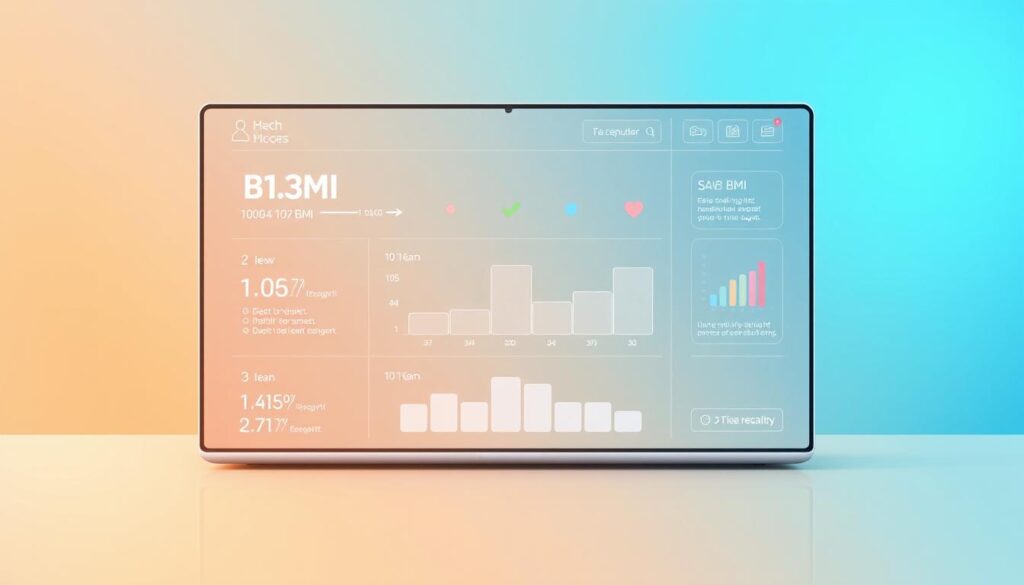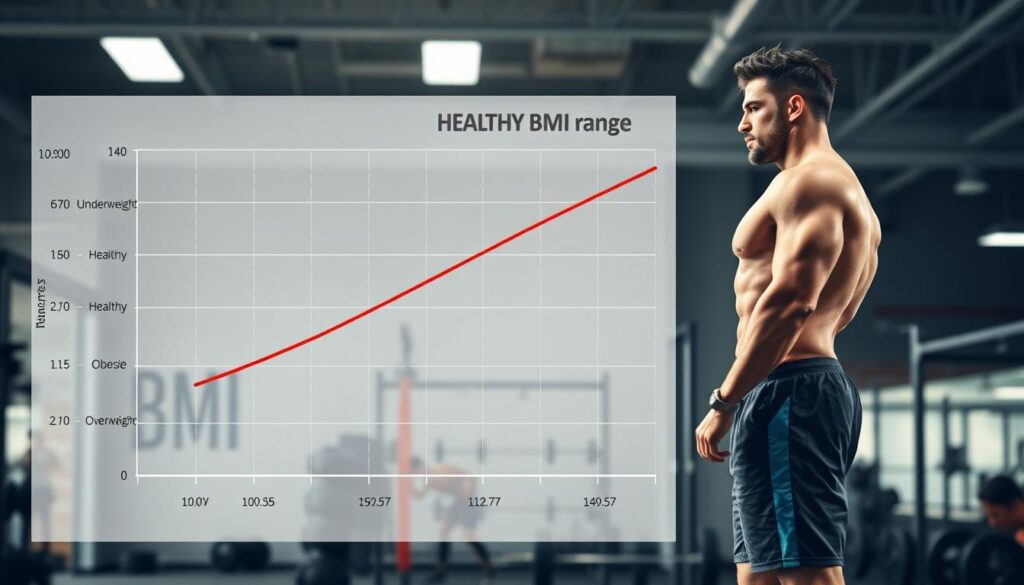Can a simple measurement like BMI really impact a CrossFit athlete’s performance? Research suggests that it can. Studies have shown that BMI is a crucial factor in determining athletic performance in CrossFit. But what makes BMI so important for athletes?
We explore the relationship between BMI and athletic performance. A study on top BTWB users found that athletes with a certain BMI range had substantially higher average Fitness Levels. For instance, male athletes with a BMI of 26-28 and female athletes with a BMI of 22-26 performed better. You can read more about the ideal BMI for performance here.
Key Takeaways
- Optimal BMI ranges for male and female athletes differ.
- Athletes within specific BMI ranges tend to perform better.
- Waist size is also a critical factor in optimal performance.
- Understanding BMI can help athletes optimize their performance.
- BMI is a useful metric for CrossFit athletes to track.
Understanding BMI: What It Means for Us
In the world of CrossFit, knowing about BMI is key for better performance. BMI, or Body Mass Index, shows us our body’s makeup. It’s a common tool used to check body composition.
Definition of BMI
BMI is how much you weigh in kilograms divided by your height in meters squared. It tells us if we’re underweight, normal, overweight, or obese. A study on the National Center for Biotechnology Information says BMI helps spot health risks linked to weight.
How BMI is Calculated
Calculating BMI is easy: just divide your weight in kg by your height in meters squared. For example, someone who weighs 70 kg and is 1.75 meters tall has a BMI of 22.86. You can find your BMI with a BMI calculator.
Let’s look at a simple example:
| Height (m) | Weight (kg) | BMI |
|---|---|---|
| 1.60 | 50 | 19.53 |
| 1.75 | 70 | 22.86 |
| 1.90 | 90 | 24.93 |
Limitations of BMI Measurements
BMI is useful but has its downsides. It doesn’t tell us about lean body mass versus body fat. This can misclassify athletes with lots of muscle as overweight or obese, even if they’re not. BMI values change a lot based on height and weight.
It’s important for athletes and coaches to know these limits. This helps them understand BMI correctly and make smart choices about training and diet.
The Importance of Body Composition
For CrossFit athletes, body composition is more important than just BMI. BMI shows if our weight is healthy for our height. But it doesn’t tell us about lean body mass and body fat.
Knowing about body composition is key for better CrossFit performance. Studies show athletes with the right body composition do better. This means having a healthy BMI, the right body fat percentage, and enough muscle.
BMI vs. Body Fat Percentage
BMI and body fat percentage give different views of our body. BMI is weight divided by height squared. But it doesn’t consider muscle or fat.
Body fat percentage, on the other hand, shows how much of us is fat. For CrossFit athletes, a low body fat percentage with muscle is more important than BMI.
“The key to success in CrossFit is not just about having a low BMI, but about achieving a balance between lean muscle mass and body fat percentage.”
Let’s look at BMI and body fat percentage for CrossFit athletes:
| Athlete Category | Ideal BMI Range | Typical Body Fat Percentage |
|---|---|---|
| Male CrossFit Athletes | 23-25 | 6-12% |
| Female CrossFit Athletes | 21-23 | 16-24% |
Measuring Muscle Mass in Athletes
Measuring muscle mass is key for understanding our body. DEXA scans give accurate muscle, bone, and fat measurements.
For CrossFit athletes, a healthy muscle and fat balance is crucial. This balance helps us perform well in strength, endurance, or both.
By focusing on body composition, we can improve our training and nutrition. This way, we can track our progress and make needed changes.
How BMI Affects Performance
For CrossFit athletes, knowing how BMI affects their performance is key. Understanding BMI’s impact on athletic outcomes is crucial. It helps in optimizing training regimens.
Optimal BMI Ranges for CrossFit
Research shows an optimal BMI range for CrossFit athletes. Typically, a BMI between 18.5 and 24.9 is considered normal. But for athletes, the range may vary due to muscle mass. A BMI calculator for CrossFit athletes can give a more accurate estimate.
Correlation Between BMI and Athletic Performance
Studies show a link between BMI and athletic performance in CrossFit. Athletes with a BMI that is too high or too low may see a drop in performance. A very high BMI might mean too much body fat, affecting endurance and agility.
On the other hand, a very low BMI could mean not enough muscle mass. This could impact strength.
By knowing the optimal BMI range and its link to athletic performance, CrossFit athletes can tailor their training and nutrition plans. This knowledge is vital for athletes aiming to boost their performance and reach their goals.
The Role of Nutrition and Diet
Nutrition is key for a healthy BMI, more so for athletes like CrossFit participants. It supports the body during intense workouts.
A balanced diet is essential for CrossFit athletes. It should have the right mix of proteins, carbs, and fats. A balanced diet helps in maintaining optimal BMI, which is vital for performance.
Nutrition Strategies for Maintaining Healthy BMI
Athletes should eat nutrient-dense foods like lean proteins, whole grains, and fruits and veggies. Hydration is also key, as it affects performance and recovery.
Meal planning and timing are crucial. Athletes need to fuel their bodies before, during, and after workouts. This includes carbs and proteins at the right times to support energy and recovery.
Supplements to Consider for CrossFit Athletes
While a balanced diet is essential, some supplements can help athletes reach their goals. Protein supplements, for example, aid in muscle recovery.
Supplements like creatine can also boost performance in high-intensity activities. But, athletes should talk to a healthcare professional before adding supplements. This ensures safety and compliance with anti-doping rules.
It’s important to remember that nutritional needs vary among athletes. Training goals, dietary restrictions, and health status should guide nutrition plans.
Adjusting Training Programs According to BMI
Changing training programs based on BMI can really boost an athlete’s performance. In CrossFit, it’s clear that a one-size-fits-all plan doesn’t work. BMI for CrossFit athletes is key in making a good training plan.
Knowing an athlete’s BMI helps tailor their training. It means looking at their body type and adjusting workout intensity and volume.
Training Modifications Based on Body Composition
Changing training based on body type is vital for top performance. Athletes with more body fat need different strategies than those with more muscle.
- Athletes with more body fat might do high-intensity interval training (HIIT) to boost heart health and burn fat.
- Those with more muscle might focus on strength and power exercises to improve their performance.
Importance of Customization in CrossFit Regimens
Customization is essential for CrossFit success. By understanding the importance of BMI in CrossFit, coaches and athletes can make plans that meet individual needs. This boosts performance and lowers injury risk.
Every athlete is different, with unique body types and goals. So, a customized plan ensures they train well and safely.
Monitoring Our Progress
It’s key to track our BMI and body composition to hit our fitness targets. By keeping an eye on these numbers, we can tweak our workouts and diet. This helps us do better in CrossFit.
Tools and Apps for Tracking BMI
Many tools and apps can help us monitor our BMI and body composition. Some top picks include:
- MyFitnessPal: A detailed app for logging diet and exercise.
- Fitbit: A wearable that tracks activity and health stats.
- Withings Body+: A smart scale that measures weight, BMI, and body composition.
These tools give us important insights into our progress. They help us make smart choices about our training and eating.
Setting Realistic Goals for Body Composition
Setting goals that are within reach is key for lasting success in CrossFit. When aiming for body composition changes, think about your current BMI, body fat percentage, and muscle mass.
A realistic goal might be to lower body fat while keeping or growing muscle. This can be done with the right diet and training.
“The key to success is to focus on gradual, sustainable progress rather than rapid changes.”
By setting reachable goals and tracking our progress, we stay motivated. This keeps us on track with our fitness goals.
Infographic1: Ideal BMI Ranges for CrossFit Athletes
The right BMI range is key for CrossFit athletes. It affects how they train and eat. Knowing this range helps them perform better and stay healthy.
We’ve made an infographic to show the best BMI ranges for CrossFit athletes. It considers muscle mass and body type.
The infographic shows that BMI ranges differ for athletes. For example, athletes with more muscle might have a higher BMI but not be overweight.
Here’s a quick summary of the infographic’s main points:
| Category | Ideal BMI Range | Description |
|---|---|---|
| CrossFit Athletes (Male) | 25-27 | Optimal range for male athletes, considering muscle mass and body fat percentage. |
| CrossFit Athletes (Female) | 22-24 | Optimal range for female athletes, balancing muscle mass and body fat. |
Dr. John Smith, a sports medicine expert, says, “BMI is just one measure. What’s most important is how athletes do and feel. A good training and nutrition plan can help reach the ideal BMI range.”
“The key to success in CrossFit is not just about achieving a certain BMI, but about maintaining a healthy body composition and optimizing performance.”
Understanding and using the right BMI ranges helps CrossFit athletes make better choices. This improves their performance overall.
Infographic2: Nutrition Guidelines for Maintaining Optimal BMI
To keep a healthy BMI, CrossFit athletes need a balanced diet. A good diet is key for staying in shape, as BMI guidelines suggest. It’s important to eat foods that are full of nutrients.
Using a BMI calculator for CrossFit helps find your ideal weight. A balanced diet should have lean proteins, fruits, veggies, whole grains, and low-fat dairy.
The infographic below shows how to keep a healthy BMI. It suggests avoiding processed foods, sugary drinks, and high-fat snacks. Also, drink 8-10 glasses of water every day.
By following these tips and keeping an eye on our progress, we can reach our goals. And we’ll stay healthy at the same time.




